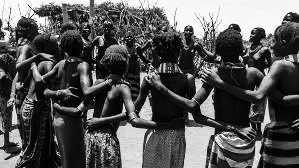
Ethiopia, in the Horn of Africa, is a rugged, landlocked country split by the Great Rift Valley. The country is rich both in historical and cultural wonders. It is also rich in archaic archaeological findings such as Lucy and Selam which date back millions of years which makes the country ‘Land of Origin’.
Among important historical sites, Aksum is the ruins of an ancient city with obelisks, tombs, castles and Churches.
Lalibela Rock-hewn Church is a historical place that dates back to the 12th–13th centuries.
Nejashi Mosque is another holy shrine that dates back to the 17th century. The mosque is a memorandum of the Abyssinian king- Negashi who warmly received the Fifteen companions of Prophet Mohammed out of good gesture and granted them refuge in the town of Negash, the present-day Tigray Region.
There are several other historical monasteries, mosques, shrines and caves in Ethiopia. The country is rich in the biosphere too. The endemic wildlife together with the unique lifestyle of the people of Ethiopia makes the countries one of the best tourist destinations in Africa.
Among the extraordinary geological wonders that Ethiopia has to offer, Danakil Depression, deep in the Afar region, the unearthly hosts two volcanoes, Erta Ale and the Dallol are unimaginable. Lava lakes, bathe in hot springs, and marvel at waterfalls makes the adventure exceptional.
Mark Angelo, a tourist, told The Ethiopian Herald that Omo Valley is one of the most fascinating sceneries in the country. The lifestyle of the people of Omo is unique. A significant number of them practice flood retreat cultivation and other traditional agro-pastoralist livelihoods. At least eight distinct indigenous communities depend on the Omo River’s flood cycle: the Mursi, Bodi, Muguji (Kwegu), Kara (Karo), Hamar, Bashada, Nyangatom, and Daasanech, he said.
Angelo described the Omo valley as the best place to visit. The variety and diversity of life – truly a melting pot of humanity – will blow you away. The concentration of experience and variety, often so juxtaposed to daily life, forces to reflect on what it means to be human in today’s world, as to him.
The Lower Omo Valley region has been registered as UNESCO World Heritage site since the discovery of human remains dating back nearly 2.5 million years. The region has fortified hilltop settlements, terraced fields, anthropomorphic grave-markers, and rock engravings dating back 5000 years.
The Omo also has some beautiful landscapes; Nech Sar National Park frames much of the region with mountains, lakes and forests, and harbors 70-plus mammal species, as well as prodigious crocodiles and the endemic Nechisar nightjar – the latter arguably the world’s rarest bird.
The region mostly lives on meager resources and over the years has been victim to cattle-rustling, violence, ethnic struggles, drought and really needs infrastructure. Tourism is vital to help support the communities, providing a basic income, and a visitor will experience a part of Africa like no other.
However, in most places – as is often the case in many parts of the world – a ceremony or dance is a pleasure to give, and a useful part of the tourist trade. It is a transaction, but a good one.
Large families live in small huts. Piercings, body markings, and circumcision is a way of life. It’s worth remembering alongside this, that simple lives are often very happy, and free from the distractions many tourists suffer in their home countries.
One of the reasons why visiting this area is so fascinating and rewarding is that it will challenge your belief systems and understanding of the world.
According to Natalia Bosak, a Swiss tourist, Omo is firmly, and deservedly, on the tourist trail. As such, experiences have been designed and many villages will have a standard dance, show or tour that they like to take people on. Despite being only tens of kilometers apart, the tribes often feel completely different from one another and so experiences can range from walking through a village as they go about daily life with little structure, a formal ceremony, to a guided tour through fortified walls. Some feel organized, others loose.
Natalia added that the variety is fun and often planned to leave you wondering at the diversity. Almost all villagers are friendly and welcoming, and children will often charm you with their playfulness.
She explained that community trekking routes are among the favorite experiences in Ethiopia. Offering a unique insight into rural Ethiopia through trails off the beaten track, are yet to find anyone who is not blown away by the beauty of the rolling hills of Lalibela, the sweeping sun-glazed panoramas of Tigray, and the kindness and warmth of the local communities. It is authentic community tourism at its absolute finest.
Will Jones an environmental scientist said that Ethiopia boasts the highest concentration of highlands in Africa and history and culture unsurpassed elsewhere on the continent. The country is fertile and diverse and occupied by a proud and friendly mix of races and religions. Due simply to its uniqueness and interest, Ethiopia has considerable potential as an alternative African travel destination for the discerning traveler.
“I believe that well-managed tourism will be of huge importance for Ethiopia, both in the interests of sensitive cultural groups and a struggling wildlife population. It requires dedication, training, investment, and a commitment from all interested stakeholders, which should include both the private and charitable sectors”, he said.
The Ethiopian Herald June 23, 2020
BY GETAHUN LEGESSE

